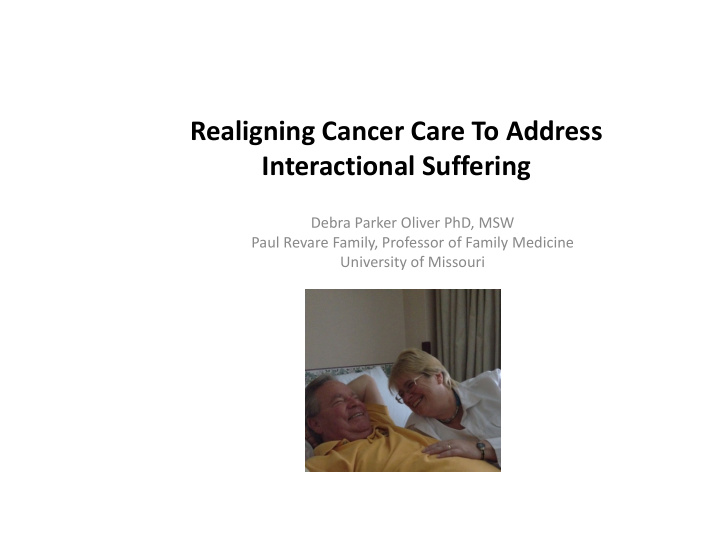



Realigning Cancer Care To Address Interactional Suffering Debra Parker Oliver PhD, MSW Paul Revare Family, Professor of Family Medicine University of Missouri
Conflicts • No conflicts to report
Rosalynn Carter “ There are only four kinds of people in the world: – Those who have been caregivers, – Those we are currently caregivers, – Those who will be caregivers, – And those who will need caregivers ”
Science of Caregiving • Intensity and duration of experience are predictors of negative health effects • Higher incidence of chronic disease • Depression/Anxiety • Social Isolation • Caregiving could be a diagnosis
Experience of Caregiving Interactional Suffering • Lack of Attention (Timely, Full attention) • Lack of understanding (Thoughts and feelings) • Lack of Communication (Empathy, hope) • Lack of Competence (Pall Care; collaboration) • Issues of Limitation (Med Science, technology) • Invisible Health Care Interactional Suffering in Palliative Care. Beng,TS; NgChong Guan;Lim Le Jane; American Journal of Hospice and Palliative Medicine. (2014), 3 (3) pg304.
What is a Labyrinth? • A circular pathway with one way in that leads directly to the endpoint. 7 Circuit’s – Transitions: Changes as you move from one circuit to another – Fork in the Road: Decision points – Blind Alley: Unexpected turn, surprises
My Labyrinth
Entrance Diagnosis And Treatment Consultation Interactional Suffering • Lack of Attention • Lack of understanding • Lack of communication • Lack of competence • Limitations • Signals of Invisibility Blind Alleys • No Map • Everyone speaks a foreign language
Treatment Interactional Suffering • Lack of Attention • Lack of understanding • Lack of communication • Lack of competence • Limitations • Signals of invisibility Forks in the Road • Scans and Symptoms
Waiting Interactional Suffering •Lack of Attention •Lack of understanding •Lack of communication •Lack of competence •Limitations •Signals of Invisibility Forks in the Road • Signs of reoccurrence Blind Alleys • False hope
Reoccurrence Interactional Suffering •Lack of Attention •Lack of understanding •Lack of communication •Lack of competence •Limitations •Signals of Invisibility Transition • Return to caregiving
Hospice Interactional Suffering •Lack of Attention •Lack of understanding •Lack of communication •Lack of competence • Transitions – Losses: private space, privacy, home to hospital
Death Interactional Suffering No More Transitions • Caregiver to widow Now to get back through alone
Family Centered Care 1. Beware of Interactional Suffering 2. Watch for Signals of Invisibility 3. Invite and Encourage caregiver involvement 4. Routinely interact with caregiver 5. Speak privately with both patient and caregiver 6. Attend to patient and family preferences for information 7. Assign team member to focus on caregiver Facilitating collaborative and effective family involvement in cancer setting: Guidelines for clinicians(TRIO guidelines) Laidsaar‐Powell, R.; Butow,P.; Boyle,R.; Juraskova,I. (2018) Patient Education and Counseling 101 970‐982.
Easy Individual Fix • Validate Caregiver – Respect knowledge • “ What problems have you seen ” – Embrace as a partner • “ What do you think about this plan ” – Recognize and hear the emotion • “ This must be very hard for you on so many levels ”
. . . To begin depriving death of its greatest advantage over us, let us adopt a way clean contrary to that common one; let us deprive death of its strangeness, let us frequent it, let us get used to it. . .We do not know where death awaits us: so let us wait for it everywhere. Michel de Montaigne � ������ �����
Thank you • oliverdr@missouri.edu • http://Legaciesfromthelivingroom.com • Amazon, Kindle, Ipad, Nook, etc
Recommend
More recommend